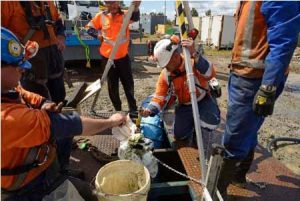 Confined spaces are areas that contain, or have the potential to contain, a hazardous atmosphere, have limited means of entry and exit, and although they are large enough for a worker to fit, they are not designed for continuous occupancy. Confined spaces require permits to enter due to their inherent risks. Confined spaces include tanks, silos, pipelines, manholes, and tunnels, just to name a few examples.
Confined spaces are areas that contain, or have the potential to contain, a hazardous atmosphere, have limited means of entry and exit, and although they are large enough for a worker to fit, they are not designed for continuous occupancy. Confined spaces require permits to enter due to their inherent risks. Confined spaces include tanks, silos, pipelines, manholes, and tunnels, just to name a few examples.
When a workplace has a confined space, the employer must have a confined space rescue plan in place. This is a multi-step process that should be well thought out before anyone attempts to enter the confined space. Steps to prepare this plan include assessing hazards, creating an extraction plan, purchasing and preparing the tools and equipment in case of an emergency, and performing practice drills. Lastly, the plan should be in writing.
Steps in Developing the Plan
The first step in developing a confined space rescue plan is taking a close look at the work environment and assessing the known potential hazards in the confined space. The second step is to anticipate what type of rescue could reasonably work, according to the nature of the physical, chemical, or other hazards found. The third step in developing the plan is to determine the exact equipment to be kept near the confined space and used in a rescue; this might include atmospheric monitors, fall protection equipment, extraction equipment, and respirators. The fourth step is equipment testing in situation simulations. The team should do drills to prepare and practice simulations of all potential incidents in the confined space. Lastly, the confined space rescue plan should be in writing, with as much detailed information as possible, including SDS sheets and descriptions of the protective gear and equipment necessary.
A WRITTEN CONFINED SPACE WRITTEN PLAN IS A MUST…911 ISN’T A RESCUE PLAN!
Download flyer: STOTW_1226_Developing_a_Confined_Space_Rescue_Plan Download Spanish flyer: STOTW_1226_Developing_a_Confined_Space_Rescue_Plan_esp

